Project Detail: Foreign Landscape
Contest:
Reportage and Documentary 2019
Brand:
LuganoPhotoDays
Author:
Dawid Zieliński
Status:
Selected
Project Info
Foreign Landscape
Wars, famine, poverty and climate change continue to drive people out from their homes, communities, countries, to the unknown. They join millions who are already on the move, constantly, restlessly, occupying spaces on the margins of the first world. Continously interacting with the landscape they encounter along the way, they leave their mark. From subtle signs in the forest undergrowths to discarded blankets to makeshift food stalls. This new and unexpected human presence is transforming the environment inhabitated and organized long ago, even if it's just a for a day, a week or a month, as they keep moving through the landscape scarred by walls and fences, running, hiding and then running again. They will continue to come. With rising sea levels, shrinking arable farmland, desertification and depleted fisheries in developing countries, millions of refugees and migrants will arrive in Europe in decades to come irreversibly altering the landscape of our children and grandchildren.
Wars, famine, poverty and climate change continue to drive people out from their homes, communities, countries, to the unknown. They join millions who are already on the move, constantly, restlessly, occupying spaces on the margins of the first world. Continously interacting with their surroundings and the landscape they encounter along the way, they leave their mark. From subtle signs in the forest undergrowths to discarded blankets to makeshift food stalls. This new and unexpected human presence is transforming the environment inhabitated and organized long ago, even if it's just a for a day, a week or a month, as they keep moving through the landscape scarred by walls and fences, running, hiding and then running again.
In 2015 and 2016, I covered the refugee crisis as it was unfolding in various European countries. Gradually, I became increasingly interested in how their arrival was transforming the landscape. Serving initially as a backdrop for their story, it gradually started to tell its own tale, one of fear and despair but also hope and resilience, among new divisions and borders brought by rapidly deteriorating political climate.
I use the word “landscape” here in a broad and inclusive meaning, because deep down this is a story about people. About individuals and communities experiencing a passage at a turning point in their lives, as well as individuals and communities coming face to face with the “other”, and various consequences arising from it.
Instead of following the routine of descriptive and news oriented work that we've seen again and again, this subject deserves more comprehensive approach. From dynamics of landscape transformations along established migration routes and to immigration enforcement and structures of control, to information and disinformation, illusions of threat and propaganda spread by local and state authorities or various groups of interest. Refugees and immigrants settling in their new homes and ones forced to exist outside organized humanitarian assistance. People braving winter's cold surviving in disused warehouses and dilapidated industrial buildings. They all need a voice. And they deserve one. Just as much as local communities, often set in their ways, living in far corners of the continent: family of farmers in Hungary, Greek tour guide or Polish truck driver. Do they feel challenged by rising immigration? Are they afraid? What do they expect?
They will continue to come. It's just a matter of time. With rising sea levels, shrinking arable farmland, desertification and depleted fisheries in developing countries, millions of refugees and migrants will arrive in Europe in decades to come irreversibly altering the landscape of our children and grandchildren.

















